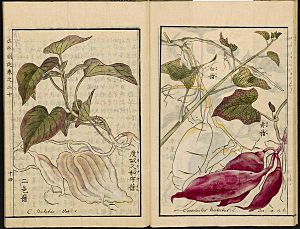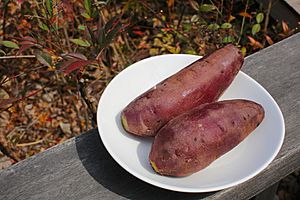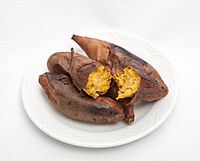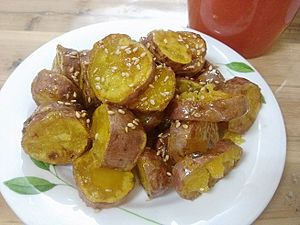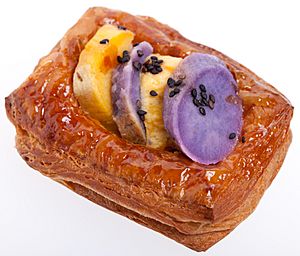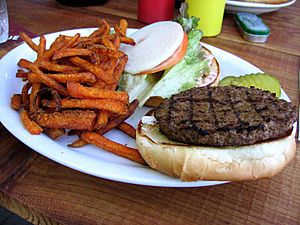Sweet potato facts for kids
Quick facts for kids Sweet Potato |
|
|---|---|
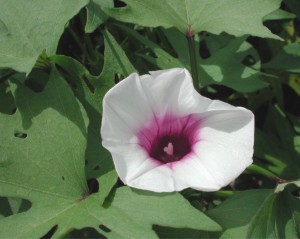 |
|
| Sweet potato in flower Hemingway, South Carolina |
|
| Scientific classification | |
| Kingdom: | |
| (unranked): | |
| (unranked): | |
| (unranked): | |
| Order: | |
| Family: | |
| Genus: | |
| Species: |
I. batatas
|
| Binomial name | |
| Ipomoea batatas (L.) Lam.
|
|
The Sweet Potato (Ipomoea batatas) is a plant that is a member of the morning glory family, grown for its sweet, edible, tuberous roots. Sweet potatoes contain a lot of fiber and beta-Carotene. They are eaten around the world.
Contents
Naming
Although the soft, orange sweet potato is often called a "yam" in parts of North America, the sweet potato is very distinct from the botanical yam (Dioscorea), which has a cosmopolitan distribution, and belongs to the monocot family Dioscoreaceae. A different crop plant, the oca (Oxalis tuberosa, a species of wood sorrel), is called a "yam" in many parts of Polynesia, including New Zealand.
Although the sweet potato is not closely related botanically to the common potato, they have a shared etymology. The first Europeans to taste sweet potatoes were members of Christopher Columbus's expedition in 1492. Later explorers found many cultivars under an assortment of local names, but the name which stayed was the indigenous Taino name of batata. The Spanish combined this with the Quechua word for potato, papa, to create the word patata for the common potato.
Some organizations and researchers advocate for the styling of the name as one word—sweetpotato—instead of two, to emphasize the plant's genetic uniqueness from both common potatoes and yams and to avoid confusion of it being classified as a type of common potato. In its current usage in American English, the styling of the name as two words is still preferred.
In Argentina, Venezuela, Puerto Rico, Brazil and the Dominican Republic the sweet potato is called batata. In Mexico, Peru, Chile, Central America, and the Philippines, the sweet potato is known as camote (alternatively spelled kamote in the Philippines), derived from the Nahuatl word camotli.
In Peru, the Quechua name for a type of sweet potato is kumar, strikingly similar to the Polynesian name kumara and its regional Oceanic cognates (kumala, umala, 'uala, etc.), which has led some scholars to suspect an instance of pre-Columbian trans-oceanic contact.
In Australia, about 90% of production is devoted to the orange cultivar named "Beauregard", which was originally developed by the Louisiana Agricultural Experiment Station in 1981.
In New Zealand, the original Māori varieties bore elongated tubers with white skin and a whitish flesh (which, it is thought, points to pre-European cross-Pacific travel). Known as kumara (now spelled kūmara in the Māori language), the most common cultivar now is the red cultivar called Owairaka, but orange ("Beauregard"), gold, purple and other cultivars are also available. Kumara is particularly popular as a roasted food, often served with sour cream and sweet chili sauce.
Origin
The origin and domestication of sweet potato occurred in either Central or South America. In Central America, domesticated sweet potatoes were present at least 5,000 years ago, with the origin of I. batatas possibly between the Yucatán Peninsula of Mexico and the mouth of the Orinoco River in Venezuela. The cultigen was most likely spread by local people to the Caribbean and South America by 2500 BCE.
The sweet potato was grown in Polynesia before western exploration as the Ipomoea batatas, which is generally spread by vine cuttings rather than by seeds. Sweet potato has been radiocarbon-dated in the Cook Islands to 1400 CE. A common hypothesis is that a vine cutting was brought to central Polynesia by Polynesians who had traveled to South America and back, and spread from there across Polynesia to Easter Island, Hawaii and New Zealand. Divergence time estimates suggest that sweet potatoes might have been present in Polynesia thousands of years before humans arrived there, although other reports dispute this.
Dispersal in historical times
Sweet potatoes were first introduced to the Philippines during the Spanish colonial period (1521-1598) via the Manila galleons, along with other New World crops. It was introduced to the Fujian province of China in about 1594 from Luzon, in response to a major crop failure. The growing of sweet potatoes was encouraged by the Governor Chin Hsüeh-tseng (Jin Xuezeng).
Sweet potatoes were also introduced to the Ryukyu Kingdom, present-day Okinawa, Japan, in the early 1600s by the Portuguese. Sweet potatoes became a staple in Japan because they were important in preventing famine when rice harvests were poor. Sweet potatoes were later planted in Shōgun Tokugawa Yoshimune's private garden. It was also introduced to Korea in 1764.
The sweet potato arrived in Europe with the Columbian exchange. It is recorded, for example, in Elinor Fettiplace's Receipt Book, compiled in England in 1604.
Production
In 2017, global production of sweet potatoes was 113 million tonnes, led by China with 64% of the world total (table). Secondary producers were Malawi and Nigeria.
Culinary uses
Although the leaves and shoots are also edible, the starchy tuberous roots are by far the most important product. In some tropical areas, they are a staple food crop.
Africa

Amukeke (sun-dried slices of root) and inginyo (sun-dried crushed root) are a staple food for people in northeastern Uganda. Amukeke is mainly served for breakfast, eaten with peanut sauce. Inginyo is mixed with cassava flour and tamarind to make atapa. People eat atapa with smoked fish cooked in peanut sauce or with dried cowpea leaves cooked in peanut sauce. Emukaru (earth-baked root) is eaten as a snack anytime and is mostly served with tea or with peanut sauce. Similar uses are also found in South Sudan.
The young leaves and vine tips of sweet potato leaves are widely consumed as a vegetable in West African countries (Guinea, Sierra Leone and Liberia, for example), as well as in northeastern Uganda, East Africa. According to FAO leaflet No. 13 - 1990, sweet potato leaves and shoots are a good source of vitamins A, C, and B2 (riboflavin), and according to research done by A. Khachatryan, are an excellent source of lutein.
In Kenya, Rhoda Nungo of the home economics department of the Ministry of Agriculture has written a guide to using sweet potatoes in modern recipes. This includes uses both in the mashed form and as flour from the dried tubers to replace part of the wheat flour and sugar in baked products such as cakes, chapatis, mandazis, bread, buns and cookies. A nutritious juice drink is made from the orange-fleshed cultivars, and deep-fried snacks are also included.
In Egypt, sweet potato tubers are known as "batata" (بطاطا) and are a common street food in winter, when street vendors with carts fitted with ovens sell them to people passing time by the Nile or the sea. The cultivars used are an orange-fleshed one as well as a white/cream-fleshed one. They are also baked at home as a snack or dessert, drenched with honey.
In Ethiopia, the commonly found cultivars are black-skinned, cream-fleshed and called "bitatis" or "mitatis". They are cultivated in the eastern and southern lower highlands and harvested during the rainy season (June/July). In recent years, better yielding orange-fleshed cultivars were released for cultivation by Haramaya University as a less sugary sweet potato with higher vitamin A content. Sweet potatoes are widely eaten boiled as a favored snack.
Asia
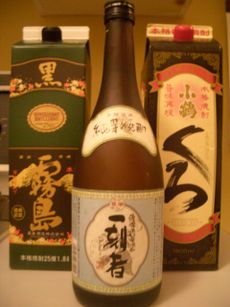
In East Asia, roasted sweet potatoes are popular street food. In China, sweet potatoes, typically yellow cultivars, are baked in a large iron drum and sold as street food during winter. In Korea, sweet potatoes, known as goguma, are roasted in a drum can, baked in foil or on an open fire, typically during winter. In Japan, a dish similar to the Korean preparation is called yaki-imo (roasted sweet potato), which typically uses either the yellow-fleshed "Japanese sweet potato" or the purple-fleshed "Okinawan sweet potato", which is known as beni-imo.
Sweet potato soup, served during winter, consists of boiling sweet potato in water with rock sugar and ginger. Sweet potato greens are a common side dish in Taiwanese cuisine, often boiled or sautéed and served with a garlic and soy sauce mixture, or simply salted before serving. They, as well as dishes featuring the sweet potato root, are commonly found at bento (Pe̍h-ōe-jī: piān-tong) restaurants. In northeastern Chinese cuisine, sweet potatoes are often cut into chunks and fried, before being drenched into a pan of boiling syrup.
In some regions of India, sweet potato is roasted slow over kitchen coals at night and eaten with some dressing while the easier way in the south is simply boiling or pressure cooking before peeling, cubing and seasoning for a vegetable dish as part of the meal. In Indian state of Tamil Nadu, it is known as 'Sakkara valli Kilangu'. It is boiled and consumed as evening snack. In some parts of India, fresh sweet potato is chipped, dried and then ground into flour; this is then mixed with wheat flour and baked into chapattis (bread). Between 15 and 20 percent of sweet potato harvest is converted by some Indian communities into pickles and snack chips. A part of the tuber harvest is used in India as cattle fodder.
In Pakistan, sweet potato is known as shakarqandi and is cooked as vegetable dish and also with meat dishes (chicken, mutton or beef). The ash roasted sweet potatoes are sold as a snack and street food in Pakistani bazaars especially during the winter months.
In Sri Lanka, it is called 'Bathala' and tubers are used mainly for breakfast (boiled sweet potato commonly with sambal or grated coconut) or as an supplementary curry dish for rice. There are many other culinary uses with sweet potato as well.
The tubers of this plant, known as kattala in Dhivehi, have been used in the traditional diet of the Maldives. The leaves were finely chopped and used in dishes such as mas huni.
In Japan, both sweet potatoes (called "satsuma-imo") and true purple yams (called "daijo" or "beni-imo") are grown. Boiling, roasting and steaming are the most common cooking methods. Also, the use in vegetable tempura is common. Daigaku-imo is a baked sweet potato dessert. Because it is sweet and starchy, it is used in imo-kinton and some other traditional sweets, such as ofukuimo. Shōchū, a Japanese spirit normally made from the fermentation of rice, can also be made from sweet potato, in which case it is called imo-jōchū. Imo-gohan, sweet potato cooked with rice, is popular in Guangdong, Taiwan and Japan. It is also served in nimono or nitsuke, boiled and typically flavored with soy sauce, mirin and dashi.
In Korean cuisine, sweet potato starch is used to produce dangmyeon (cellophane noodles). Sweet potatoes are also boiled, steamed, or roasted, and young stems are eaten as namul. Pizza restaurants such as Pizza Hut and Domino's in Korea are using sweet potatoes as a popular topping. Sweet potatoes are also used in the distillation of a variety of Soju. A popular Korean side dish or snack, goguma-mattang, also known as Korean candied sweet potato, is made by deep frying sweet potatoes that were cut into big chunks and coating them with caramelized sugar.
In Malaysia and Singapore, sweet potato is often cut into small cubes and cooked with taro and coconut milk (santan) to make a sweet dessert called bubur caca or "bubur cha cha". A favorite way of cooking sweet potato is deep frying slices of sweet potato in batter, and served as a tea-time snack. In homes, sweet potatoes are usually boiled. The leaves of sweet potatoes are usually stir-fried with only garlic or with sambal belacan and dried shrimp by Malaysians.

In the Philippines, sweet potatoes (locally known as camote or kamote) are an important food crop in rural areas. They are often a staple among impoverished families in provinces, as they are easier to cultivate and cost less than rice. The tubers are boiled or baked in coals and may be dipped in sugar or syrup. Young leaves and shoots (locally known as talbos ng kamote or camote tops) are eaten fresh in salads with shrimp paste (bagoong alamang) or fish sauce. They can be cooked in vinegar and soy sauce and served with fried fish (a dish known as adobong talbos ng kamote), or with recipes such as sinigang. The stew obtained from boiling camote tops is purple-colored, and is often mixed with lemon as juice. Sweet potatoes are also sold as street food in suburban and rural areas. Fried sweet potatoes coated with caramelized sugar and served in skewers (camote cue) are popular afternoon snacks. Sweet potatoes are also used in a variant of halo-halo called ginatan, where they are cooked in coconut milk and sugar and mixed with a variety of rootcrops, sago, jackfruit, and bilu-bilo (glutinous rice balls). Bread made from sweet potato flour is also gaining popularity. Sweet potato is relatively easy to propagate, and in rural areas that can be seen abundantly at canals and dikes. The uncultivated plant is usually fed to pigs.
In Indonesia, sweet potatoes are locally known as ubi jalar (lit: spreading tuber) and are frequently fried with batter and served as snacks with spicy condiments, along with other kinds of fritters such as fried bananas, tempeh, tahu, breadfruits, or cassava. In the mountainous regions of West Papua, sweet potatoes are the staple food among the natives there. Using the bakar batu way of cooking (free translation: burning rocks), rocks that have been burned in a nearby bonfire are thrown into a pit lined with leaves. Layers of sweet potatoes, an assortment of vegetables, and pork are piled on top of the rocks. The top of the pile then is insulated with more leaves, creating a pressure of heat and steam inside which cooks all food within the pile after several hours.
Young sweet potato leaves are also used as baby food particularly in Southeast Asia and East Asia. Mashed sweet potato tubers are used similarly throughout the world.
United States
Candied sweet potatoes are a side dish consisting mainly of sweet potatoes prepared with brown sugar, marshmallows, maple syrup, molasses, orange juice, marron glacé, or other sweet ingredients. It is often served in America on Thanksgiving. Sweet potato casserole is a side dish of mashed sweet potatoes in a casserole dish, topped with a brown sugar and pecan topping.
The sweet potato became a favorite food item of the French and Spanish settlers and thus continued a long history of cultivation in Louisiana. Sweet potatoes are recognized as the state vegetable of North Carolina. Sweet potato pie is also a traditional favorite dish in Southern U.S. cuisine. Another variation on the typical sweet potato pie is the Okinawan (Sweet Potato) Haupia pie, which is made with purple sweet potatoes, native to the island of Hawaii and believed to have been originally cultivated as early as 500 CE.
The fried sweet potatoes tradition dates to the early nineteenth century in the United States. Sweet potato fries or chips are a common preparation, and are made by julienning and deep frying sweet potatoes, in the fashion of French fried potatoes. Roasting sliced or chopped sweet potatoes lightly coated in animal or vegetable oil at high heat became common in the United States at the start of the 21st century, a dish called “sweet potato fries”. Sweet potato mash is served as a side dish, often at Thanksgiving dinner or with barbecue.
John Buttencourt Avila is called the "father of the sweet potato industry" in North America.
New Zealand
Before European contact, the Māori grew several varieties of small, yellow-skin, finger-sized kumara (with names including taputini, taroamahoe, pehu, hutihuti, and rekamaroa) that they had brought with them from east Polynesia. Modern trials have shown that these smaller varieties were capable of producing well, but when American whalers, sealers and trading vessels introduced larger cultivars in the early 19th century, they quickly predominated.
Māori traditionally cooked the kūmara in a hāngi earth oven. This is still a common practice when there are large gatherings on marae.
In 1947 black rot (Ceratocystis fimbriata) appeared in kumara around Auckland and increased in severity through the 1950s. A disease-free strain was developed by Joe and Fay Gock. They gifted the strain to the nation, later in 2013 earning them the Bledisloe Cup.
There are three main cultivars of kumara sold in New Zealand: 'Owairaka Red' ("red"), 'Toka Toka Gold' ("gold"), and 'Beauregard' ("orange"). The country grows around 24,000 tonnes of kumara annually, with nearly all of it (97%) grown in the Northland region. Kumara are widely available throughout New Zealand year-round, where they are a popular alternative to potatoes.
Kumara are an integral part of roast meals in New Zealand. They are served alongside such vegetables as potatoes and pumpkin and, as such, are generally prepared in a savory manner. Kumara are ubiquitous in supermarkets, roast meal takeaway shops and hāngi.
Other
Among the Urapmin people of Papua New Guinea, taro (known in Urap as ima) and the sweet potato (Urap: wan) are the main sources of sustenance, and in fact the word for "food" in Urap is a compound of these two words.
In Spain, sweet potato is called boniato. On the evening of All Souls' Day, in Catalonia (northeastern Spain) it is traditional to serve roasted sweet potato and chestnuts, panellets and sweet wine. The occasion is called La Castanyada. Sweet potato is also appreciated to make cakes or to eat roasted through the whole country.
In Peru, sweet potatoes are called 'camote' and are frequently served alongside ceviche. Sweet potato chips are also a commonly sold snack, be it on the street or in packaged foods.
Dulce de batata is a traditional Argentine, Paraguayan and Uruguayan dessert, which is made of sweet potatoes. It is a sweet jelly, which resembles a marmalade because of its color and sweetness but it has a harder texture, and it has to be sliced in thin portions with a knife as if it was a pie. It is commonly served with a portion of the same size of soft cheese on top of it.
In the Veneto (northeast Italy), sweet potato is known as patata mericana in the Venetian language (patata americana in Italian, meaning "American potato"), and it is cultivated above all in the southern area of the region; it is a traditional fall dish, boiled or roasted.
Globally, sweet potatoes are now a staple ingredient of modern sushi cuisine, specifically used in maki rolls. The advent of sweet potato as a sushi ingredient is credited to chef Bun Lai of Miya's Sushi, who first introduced sweet potato rolls in the 1990s as a plant-based alternative to traditional fish-based sushi rolls.
Nonculinary uses
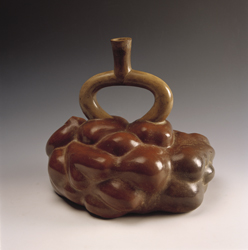
Ceramics modeled after sweet potatoes or camotes are often found in Moche culture.
In South America, the juice of red sweet potatoes is combined with lime juice to make a dye for cloth. By varying the proportions of the juices, every shade from pink to black can be obtained. Purple sweet potato color is also used as a ‘natural’ food coloring.
Cuttings of sweet potato vine, either edible or ornamental cultivars, will rapidly form roots in water and will grow in it, indefinitely, in good lighting with a steady supply of nutrients. For this reason, sweet potato vine is ideal for use in home aquariums, trailing out of the water with its roots submerged, as its rapid growth is fueled by toxic ammonia and nitrates, a waste product of aquatic life, which it removes from the water. This improves the living conditions for fish, which also find refuge in the extensive root systems.
See also
 In Spanish: Ipomoea batatas para niños
In Spanish: Ipomoea batatas para niños



